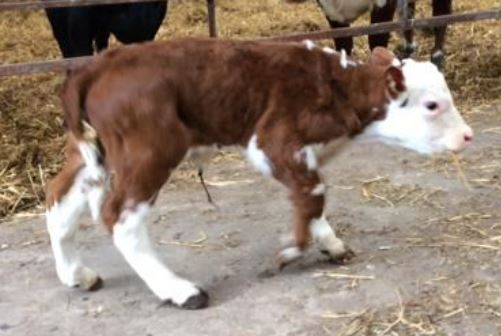Are You At Risk Of Long Bone Deformity?
3 November 2021Long bone deformity appears to have a higher occurrence amongst beef suckler herds. Calves are born with a dwarf like appearance as a result of the shortening of the long bones in the legs, giving them a characteristically short, bow-legged appearance. They may also have dished faces and domes heads, in very severe cases calves can struggle to stand and suckle. While the reasons behind it are not clear we do know it is not a genetic defect and appears to be nutrition related.
While we know long bone deformity (LBD) of calves occurs when high levels of certain types of silage are fed to pregnant cows, we do not know the exact cause and hence cannot predict when it might happen. Some herds never see it, some occasionally and some would regularly if they didn’t take precautions. Below are some factors it does appear to be associated with: –
- High quality silage. It is less common to see LBD with poorer silages. In general, it occurs with good quality silages made from young leafy swards be more common in high clover silages (particularly red clover silages).
- It is more likely to occur in silages with an ME higher than 10.8 MJ ME/kg DM, protein levels over 100g CP/kg DM and with a silage intake potential (SIP) of over 100.
- The danger period is the fourth month of pregnancy. With the wet weather forcing spring calving cows to be fed silage earlier than normal more cows will be at the critical four-month stage of pregnancy when silage feeding starts.
- Calving period. It is less likely to occur in autumn calving herds more likely spring calving herds where cows are being fed silage in the fourth and fifth month of pregnancy.
- The risk increases if your herd is fed silage ad-lib or silage accounts for more than 75% of their total daily dry matter intake in the fourth-fifth month of pregnancy.
- The area where you farm. Last year vet practices reported affected herds to the SRUC Surveillance hubs in Aberdeen, Ayr, Dumfries, Perth and St Boswells. Historically there have also seen cases reported in Inverness. Ask around if it does occur locally, then your herd may be at risk.
NB remember it is not unusual for cows to be fed ad-lib silage prior to being housed, particularly in an open autumn. Unless there are plentiful supplies of grass available it is likely that cows will eat more than 75% of their daily dry matter intake as silage.
Recommendations:
- Avoid feeding more the 75% of the cows’ daily dry matter intake from silage in the at-risk months. Bulk out rations with alternative feeds such as straw or other low-quality forages – seek nutritional advice.
- There is thought to be a link to manganese deficiency/lock up (although silage is plentiful in manganese). Feed a mineral containing higher levels of manganese (cheap to add). The target would be a mineral containing 7,000ppm of manganese, fed at 150g/cow per day.
Mary Young, mary.young@sac.co.uk
Sign up to the FAS newsletter
Receive updates on news, events and publications from Scotland’s Farm Advisory Service

